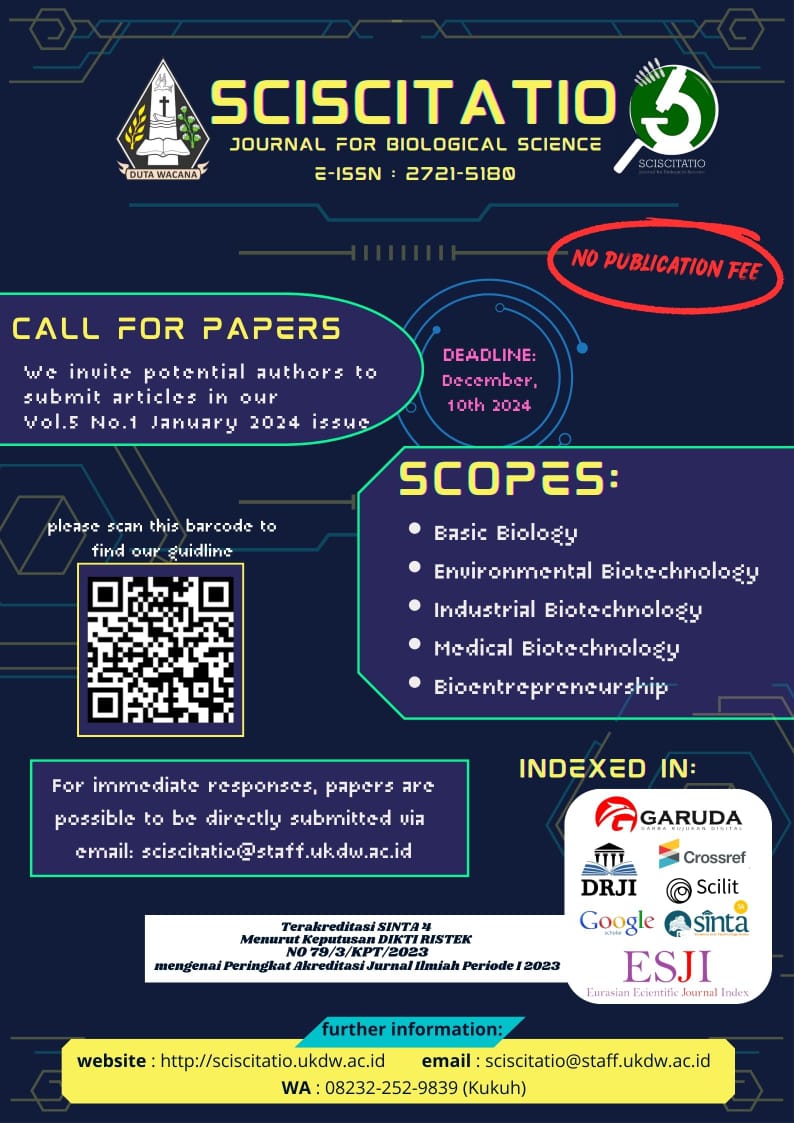Antibacterial Activity of Lime Peel and Lemongrass Extract as Active Ingredients for Spray Hand Sanitizer
Keywords:
: antibacterial, lime peel, lemongrass, spray hand sanitizer, Staphylococcus aureusAbstract
Hand sanitizers are widely used as an alternative way to maintain hand hygiene from the presence of
pathogenic bacteria, such as Staphylococcus aureus. In general, excessive use of alcohol as the main ingredient
in hand sanitizers might cause skin irritation. Utilizing antibacterial activity of plants as a component in hand
sanitizer could be used as a substitution for alcohol. The aim of this study was to determine the potential
antibacterial activity of lime peel and lemongrass extracts as active ingredients for hand sanitizer. Method
used in this research included extraction using maceration, qualitative phytochemical test, antibacterial
assay, and formulation of spray hand sanitizer and quality test of spray hand sanitizer. In this study alkaloid,
flavonoid, saponin, tannin and terpenoid were found as phytochemical content of lime peel, while lemongrass
extract contain fla vonoid, tanin, saponin and steroid. Compared to lemongrass extract, lime peel extract with
concentration 40%showed the optimum inhibition zone of S. aureus and chosen as active ingredient in spray
hand sanitizer formulation. Formulated spray hand sanitizer with lime peel extract was able to inhibit the
growth of S. aureus bacteria on hand palm.
References
Anonim. (2017). Sabun Cair Pembersih Tangan. SNI 2588:2017. Badan Standardisasi Nasional, Indonesia.
Balouiri, M., Sadiki, M., & Ibnsouda, S. K. (2016). Methods for in vitro evaluating antimicrobial activity: A review. Journal of Pharmaceutical Analysis. Elsevier, 6(2), 71–79. doi: 10.1016/j.jpha.2015.11.005.
Barbieri, R., Coppo, E., Marchese, A., Daglia, M., Sanchez, E.S., Nabavi, S. F., & Nabavi, S. M. (2017). Phytochemicals for human disease: An update on plant-derived compounds antibacterial activity. Microbiological Research. Elsevier GmbH, 196, 44–68. doi: 10.1016/j.micres.2016.12.003.
Caesar, L. K & Cech, N. B. (2019). Synergy and antagonism in natural product extracts: When 1 + 1 does not equal 2, Natural Product Reports. Royal Society of Chemistry, 36(6), 869–888. doi: 10.1039/c9np00011a.
Chandra, R. A., Yunita, R., Wahyuni, D. D., & Anggraini, D. R. (2018). Daya Antibakteri Ekstrak Buah Belimbing Wuluh (Averrhoa bilimbi Linn) Terhadap Methicillin Resistant Staphylococcus aureus. Essential, 16(1), 46.
Cowan, M. M. (1999). Plant Products as Antimicrobial Agents. Clinical Microbiology Reviews, pp. 564–582.
Edmonds-Wilson, S. L., Nurinova, N. I., & Zapka, C. A. (2015). Review of human hand microbiome research. Journal of Dermatological Science. Japanese Society for Investigative Dermatology, 80(1), 3–12. doi: 10.1016/j.jdermsci.2015.07.006.
Grace, X. F. Sowmya, K. V., Darsika, C., Arul, J., & Shanmuganathan, S. (2015). Polyherbal Hand Sanitizer - Formulation and Evaluation. Short Communication, 2(June), 143–144.
Guimarães, A. C., Meireles, L. M ., Lemos, M. F., Guimarães, M. C. C., Edringer, D. C., Fronza, M., & Scherer, R. (2019). Antibacterial activity of terpenes and terpenoids present in essential oils. Molecules, 24(13),1–12. doi: 10.3390/molecules24132471.
Harris, L. G., Richard, R. G., & Foster, S. J. (2002). An introduction to Staphylococcus aureus, and techniques for identifyingand quantifying S. aureus adhesins in relation to adhesion to biomaterials:Review. European Cells and Materials, 4, 39–60. doi: 10.22203/ecm.v004a04.
Karou, D. S., Savadogo, A., Canini, A., & Yameogo, S. (2005). Antibacterial activity of alkaloids from Sida acuta. African Journal of Biotechnology, 4(12), 1452–1457. doi: 10.5897/AJB2005.000-3192.
Kumar, A., Narayani, M., Jayakumar, M., & Subanthini, A. (2011). Antimicrobial Activity and Phytochemical Analysis of Citrus Fruit Peels -Utilization of Fruit Waste. International Journal of Engineering Science and Technology, 3(6), 5414–5421.
Kumar, S., Dobos, G. J., & Rampp, T. (2017). The Significance of Ayurvedic Medicinal Plants. Journal of Evidence-Based Complementary and Alternative Medicine, 22(3), 494–501. doi: 10.1177/2156587216671392.
Lake, W. K., Hamid, I. S., Saputro, A. L., Plumeriastuti, H., Yustinasari, L. R., & Yunita, M. N. (2019). Uji Aktivitas Antibakteri dari Ekstrak n-Heksana dan Kloroform Daun Sirsak (Annona muricate L.) Terhadap Pertumbuhan Bakteri Staphylococcus aureus Secara In Vitro. Jurnal Medik Veteriner, 2(1), 60. doi: 10.20473/jmv.vol2.iss1.2019.60-65.
Manvitha, K & Bidya, B. (2010). Plants Profile for Cymbopogon nardus (Citronella grass). International Journal of Herbal Medicine, 1(6),5–7. doi: 10.1007/BF02135660.
Martono, C & Suharyani, I. (2018). Formulasi sediaan spray gel antiseptik dari ekstrak etanol lidah buaya. Jurnal Farmasi Muhammadiyah Kuningan, 3(1), 29–37.
Nuria, M. C., Faizatun, A., & Sumantri. (2009). Uji Aktivitas Antibakteri Ekstrak Etanol Daun Jarak Pagar (Jatropha curcas L) Terhadap Bakteri Staphylococcus aureus ATCC 25923, Escherichia coli ATCC 25922, dan Salmonella thypi ATCC 1408’, 5(2), 26–37.
Rahman, F. A., Haniastuti, T., & Utami, T. W. (2017). Skrining fitokimia dan aktivitas antibakteri ekstrak etanol daun sirsak (Annona muricata L.) pada Streptococcus mutans ATCC 35668. Majalah Kedokteran Gigi Indonesia, 3(1), p. 1. doi: 10.22146/majkedgiind.11325.
Umar, M. Mohammed, I. B., Oko, J. O., & Tafinta, I. Y. (2016). Phytochemical Analysis and Antimicrobial Effect of Lemon Grass (Cymbopogon citratus) Obtained From Zaria, Kaduna State, Nigeria. Journal of Complementary and Alternative Medical Research, 1(2), 1–8. doi: 10.9734/jocamr/2016/26783.
Wardani, R., Jekti, D. S. D., & Sedijani, P. (2018). Uji Aktivitas Antibakteri Ekstrak Kulit Buah Jeruk Nipis (Citrus aurantifolia Swingle) Terhadap Pertumbuhan Bkateri Isolat Klinis. Jurnal Penelitian Pendidikan IPA, 5(1). doi: 10.29303/jppipa.v5i1.101.


